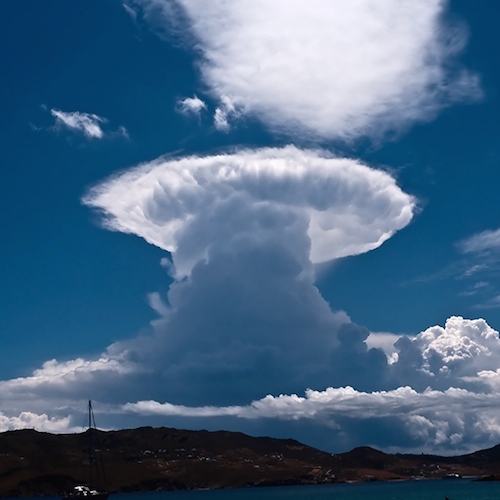 Intelligent Design
Intelligent Design
The Cold Trap: How It Works

In a post yesterday, I mentioned that if the physical and chemical properties of water were not almost exactly as they are, there would be no cold trap to prevent the loss of hydrogen to space and the consequent evaporation of the oceans.
Here is how that works. As water vapor ascends in the atmosphere, it cools and condenses out, forming clouds and rain and snow and falling back to the Earth. This process becomes very intense at the so-called tropopause (17-10 km above sea level) where air temperatures reach -80�C and all remaining water in the atmosphere is frozen out. The air in the layer of the atmosphere above the troposphere in the stratosphere (extending up to 50 km above mean sea level) is absolutely dry, containing oxygen, nitrogen, some CO2 and the other atmospheric gases, but virtually no H2O molecules. See above for a dramatic picture showing ascending clouds being abruptly stalled at this level. Note the teleological significance of all the H2O being trapped at or below the tropopause.
As the atmosphere is ascended the density decreases and the absorption of harmful radiation by the atmospheric gases becomes less and less effective. The result is that above 80-100 km, atoms and molecules are subject to intense ionizing radiation. If water ascended to this level it would be photo-dissociated into hydrogen and oxygen and, the hydrogen being very light, lost into space. Over a relatively short geological period all the water and oceans would be evaporated and the world uninhabitable. Venus, having a much less effective cold trap and being so much closer to the Sun, suffered this fate and lost its oceans long ago, turning into a hellish hot house.
But there is another delicious teleological twist to the story — as in so many other aspects of nature’s fitness. Oxygen, having a boiling point of -183�C, has no such problems ascending through the tropopause cold trap into the stratosphere. As it does, it becomes subject to more and more intense ionizing radiation. However this leads not to a disastrous loss of hydrogen as in the case with water — in any event O2 and O3 as well as N2 and CO2 are too heavy to be lost — but to the formation of ozone (O3). This forms a protective layer in the atmosphere above the tropopause, perfectly placed just above the cold trap and preventing any ionizing radiation in the far UV region from reaching the H2O molecules at the tropopause and in the troposphere below.
This protective layer acts as a fail-safe. It ensures that no ionizing, or vanishingly small amounts, ever meets a water molecule anywhere in the atmosphere, even in the lower regions at and below the tropopause. Of course the ozone layer also protects all life from energetic UV and hence is a crucial factor in rendering any Earth-like planet with oxygenic atmosphere habitable by complex life, especially terrestrial life, where the water column can provide no protection.
Here the very different physical and chemical properties of gaseous oxygen and water — both essential building block of life, and both necessary and inevitable constituents of any planetary atmosphere supporting complex life — are just right. They are just right in a number of crucial ways to preserve liquid water on the Earth’s surface in massive quantities. Water can thus play a critical role in maintaining temperature stability through its thermal and chemical properties (combining with the minerals of the crustal plates, forming amphibolic minerals), conferring on the oceanic crustal plates just the right physical properties (the right viscosity, for example) to allow them to slide slowly across the mantle.
Photo source: Wikipedia.
